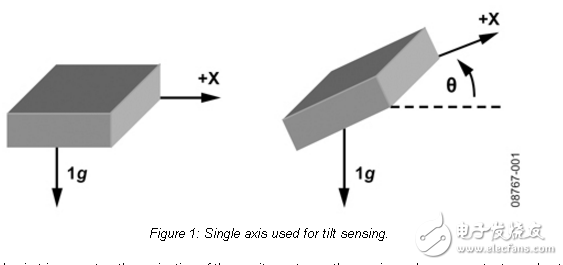
资料下载

用加速度计进行倾斜传感
用加速度计进行倾斜传感
当用户旋转手机时,手机通常会改变屏幕方向。本文讨论了将加速度计的输出转换为倾角的基本原理和所需的计算。
确定系统倾斜或倾斜的一种常用方法是将陀螺仪的输出集成起来。虽然这种方法很简单,但随着积分周期的增加,与零偏置稳定性相关的错误也可以迅速地合成,即使在设备静止时也会引起明显的旋转。
在某些应用中,随着时间的推移,系统上的净加速度或力是重力,加速度计可以用来测量倾斜或倾斜的静态角度。这些应用包括游戏、数码相机中的地平线检测以及在工业和医疗应用中检测设备的标题。
加速度计倾斜传感的基本假设是,唯一的加速度刺激是与重力有关的。实际上,可以对信号输出执行信号处理,以去除输出信号中的高频内容,因此可以容忍一些交流加速度。

Inclination sensing uses the gravity vector, and its projection on the axes of the accelerometer, to determine the tilt angle. Because gravity is a DC acceleration, any forces that result in an additional DC acceleration corrupt the output signal and result in an incorrect calculation. Sources of DC acceleration include the period of time when a vehicle is accelerating at a constant rate and rotating devices that induce a centripetal acceleration on the accelerometer. In addition, rotating an accelerometer through gravity causes an apparent AC acceleration as the projection of gravity on the axes of interest changes. Any filtering of the acceleration signal before calculating the inclination affects how quickly the output settles to the new static value.
This article discusses the basic principles for converting the output of an accelerometer to an angle of inclination. This discussion includes how to calculate the ideal inclination angle for a single-axis, dual-axis, or triple-axis solution. In addition, some basic information about calibration is included to reduce error from offset and sensitivity mismatch.
声明:本文内容及配图由入驻作者撰写或者入驻合作网站授权转载。文章观点仅代表作者本人,不代表电子发烧友网立场。文章及其配图仅供工程师学习之用,如有内容侵权或者其他违规问题,请联系本站处理。 举报投诉
- 相关下载
- 相关文章





